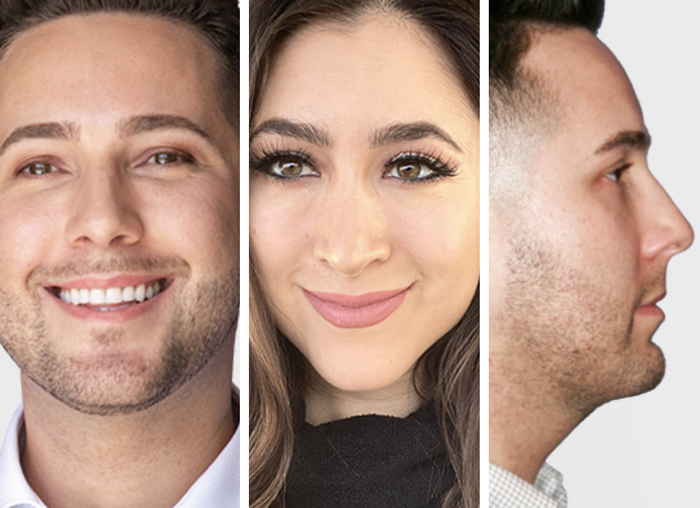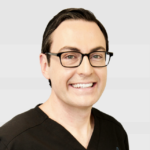Lower eyelid fullness and dark circles around the eyes make you look tired or even ill in some cases – no matter how good you feel or how much sleep you get! This is a common problem as we age, and is related to a number of changes in the face. First, the thin, “crepey” skin in the lower eyelid is stretched and dragged down by the relatively heavy cheek tissues. This exposes the underlying bone of the eye socket (orbital rim) and can give a hollow appearance. Second, the fat pads that surround the eyeball begin to bulge forward as their connective tissue capsule (orbital septum) weakens. This gives a “double contour” or “double bubble” effect – where there are two curves in the lower eyelid and upper cheek, rather than the more youthful, smooth, single contour. Aesthetic issues with the lower eyelids are not always related to age, however, and actually can be hereditary in some patients. Some people have fullness (malar bags) or obvious lines in the under-eye area even in their youth, and others may suffer from recurrent swelling without an identifiable cause (blepharochalasis).
Explore our
Patient Gallery
*Actual patients in photos

When there is too much skin or bulging fat in the lower eyelids, Dr. Ransom can treat this complex area with a surgical procedure called a lower blepharoplasty (lower eyelid lift). There are multiple approaches to lower eyelid rejuvenation, and different patients require specific techniques. Dr. Ransom performs a careful examination of each patient to determine the laxity (looseness) of the eyelids, presence and amount of excess skin, and distribution of adipose tissue (fat pads) around the eye and in the upper cheek (sometimes called the sub-orbicularis oculi fat, or SOOF). For younger patients or those without any loose skin, the fat pads can be treated without making an incision in the eyelid skin. This minimizes the risk of lower eyelid malposition and speeds up recovery. For patients that have loose eyelids, excess skin, or a hollow-appearance, Dr. Ransom performs the latest technique in lower blepharoplasty, which uses your own fat pads to fill in the hollow areas and removes hanging or “crepey” skin.
These procedures are performed with general anesthesia or IV sedation and may be combined with other aesthetic procedures such as rhytidectomy (facelift), upper blepharoplasty (upper eyelid lift), and browlift, or non-surgical treatments such as laser resurfacing for fine wrinkles around the eyes (crow’s feet).
Who is a candidate?
Anyone with lower eyelid bags, extra or loose skin and muscle, tired-appearing eyes, or hollow eyes with dark circles is a candidate for a lower eyelid lift. During your consultation, Dr. Ransom will closely examine your upper eyelid area, including skin laxity, position at rest, movement, eye closure, and tear film (lacrimal status, or dry eyes). In some cases, the unaesthetic appearance of the lower eyelids is related to a lifelong problem with soft tissue edema (blepharochalasis) or thyroid disease (myxedema). These cases require special attention, and Dr. Ransom would be happy to discuss this in your consultation. Dr. Ransom uses a variety of techniques to rejuvenate the lower eyelid and upper cheek complex and believes that a youthful midface and lower eyelid contour is the hallmark of natural beauty. During your confidential consultation, Dr. Ransom can review different approaches to the lower eyelid lift and help you decide on the best treatment for your unique situation.
Frequently Asked Questions
Please note that all patients are different and individual healing times and results may vary. The statements regarding procedures and recovery made here are general rules.
Immediately following the surgery, the lower eyelids will have some bruising and swelling. In most cases, this is relatively mild. Swelling generally reaches a maximum by the second day after the surgery, and then begins to recede rapidly. This process typically takes about a week. Patients are encourage to keep the head elevated and use around the clock cold compresses during this time, and strenuous activity is avoided. Pain is very minimal, and any sudden increase in pain should be reported to the doctor immediately. Most patients are more than comfortable with one week away from work. After the sutures are removed on the fourth day, incisions are well-camouflaged by the eyelashes. Eye makeup can be worn after the first week, and the incisions are nearly imperceptible within a couple weeks of the procedure.
Having a lower eyelid lift will not change the shape of the eyes. In the first few days after surgery, when the area is still swollen and the sutures are in place, the eyes will look puffy and it may be difficult to see their exact shape. However, after healing, the desired effect of the lower eyelid lift is seen – a smoother and more youthful contour of the lower eyelid and upper cheek area, without bags or hollows and dark circles that made you look tired. You will appreciate the increased brightness of the eyes. Dr. Ransom would be happy to review the procedure in detail and patient photos with you during your consultation.
Dr. Evan Ransom is an Ivy League-educated and Ivy League trained Facial Plastic and Reconstructive Surgeon. He is a Double Board Certified Head and Neck Surgeon and Facial Plastic and Reconstructive Surgery and fellowship-trained in facial plastic, reconstructive, and laser surgery. His practice is in the San Francisco Bay Area, serving patients from San Francisco, Oakland, Marin County, Palo Alto, Silicon Valley, Walnut Creek, the East Bay, and all over Northern California.
 (415) 550-1077
(415) 550-1077 San Francisco
San Francisco




